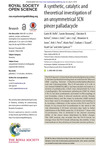Please use this identifier to cite or link to this item:
http://lib.hpu.edu.vn/handle/123456789/23611Full metadata record
| DC Field | Value | Language |
|---|---|---|
| dc.contributor.author | Roffe, Gavin W. | en_US |
| dc.contributor.author | Boonseng, Sarote | en_US |
| dc.contributor.author | Baltus, Christine B. | en_US |
| dc.date.accessioned | 2016-10-11T05:37:32Z | |
| dc.date.available | 2016-10-11T05:37:32Z | |
| dc.date.issued | 2016 | en_US |
| dc.identifier.other | HPU4160716 | en_US |
| dc.identifier.uri | https://lib.hpu.edu.vn/handle/123456789/23611 | en_US |
| dc.description.abstract | The SCN ligand 2-{3-[(methylsulfanyl)methyl]phenyl}pyridine, 1, has been synthesized starting from an initial Suzuki–Miyaura (SM) coupling between 3-((hydroxymethyl)phenyl)boronic acid and 2-bromopyridine. The C–H activation of1within situformed Pd(MeCN)4(BF4)2has been studied and leads to a mixture of palladacycles, which were characterized by X-ray crystallography. The monomeric palladacycle LPdCl6,where L-H=1, has been synthesized, and tested in SM couplings of aryl bromides, where it showed moderate activity. Density functional theory and the atoms in molecules (AIM) method have been used to investigate the formation and bonding of 6, revealing a difference in the nature of the Pd–S and Pd–N bonds. | en_US |
| dc.format.extent | 15 p. | en_US |
| dc.format.mimetype | application/pdf | en_US |
| dc.language.iso | en | en_US |
| dc.subject | Chemistry | en_US |
| dc.subject | Computational chemistry | en_US |
| dc.subject | Crystallography | en_US |
| dc.subject | Organometallic chemistry | en_US |
| dc.subject | Palladium | en_US |
| dc.subject | C–H activation | en_US |
| dc.subject | Calculations | en_US |
| dc.title | A synthetic, catalytic and theoretical investigation of an unsymmetrical SCN pincer palladacycle | en_US |
| dc.type | Article | en_US |
| dc.size | 1.65MB | en_US |
| dc.department | Education | en_US |
| Appears in Collections: | Education | |
Files in This Item:
| File | Description | Size | Format | |
|---|---|---|---|---|
| 0599_Asynthetic.pdf Restricted Access | 1.69 MB | Adobe PDF |  View/Open Request a copy |
Items in DSpace are protected by copyright, with all rights reserved, unless otherwise indicated.
